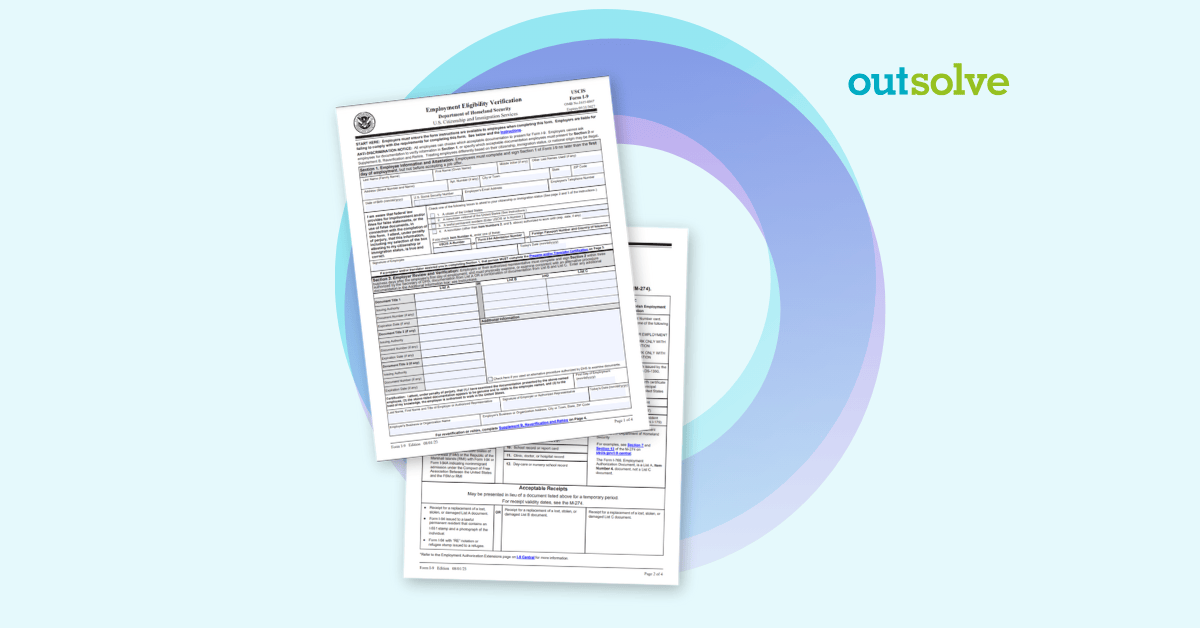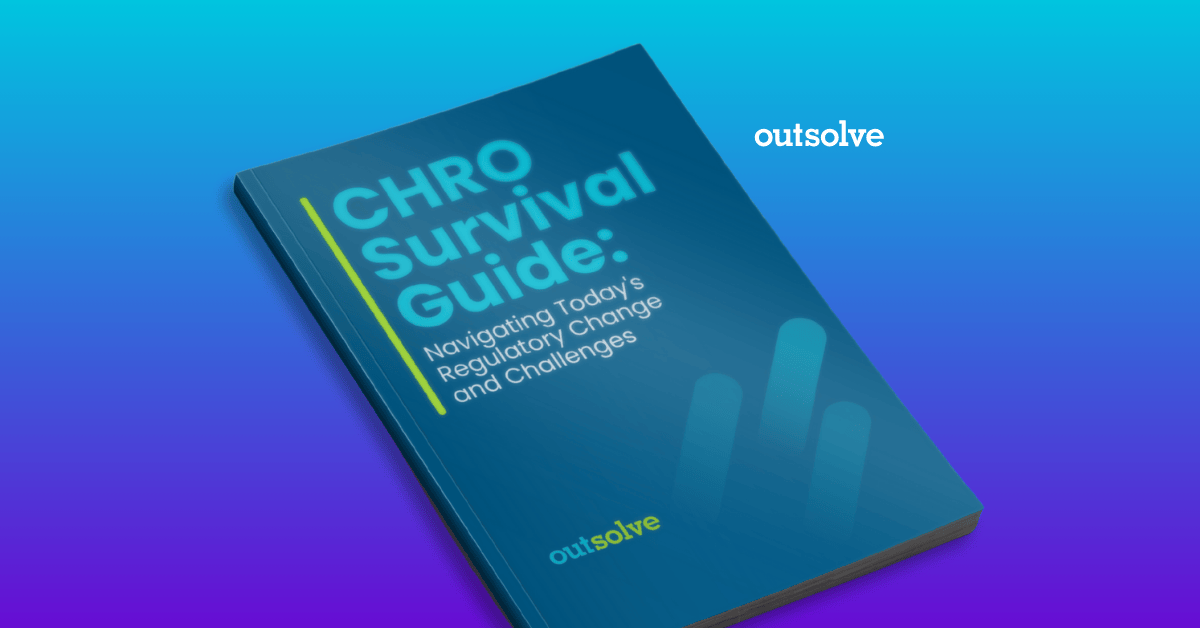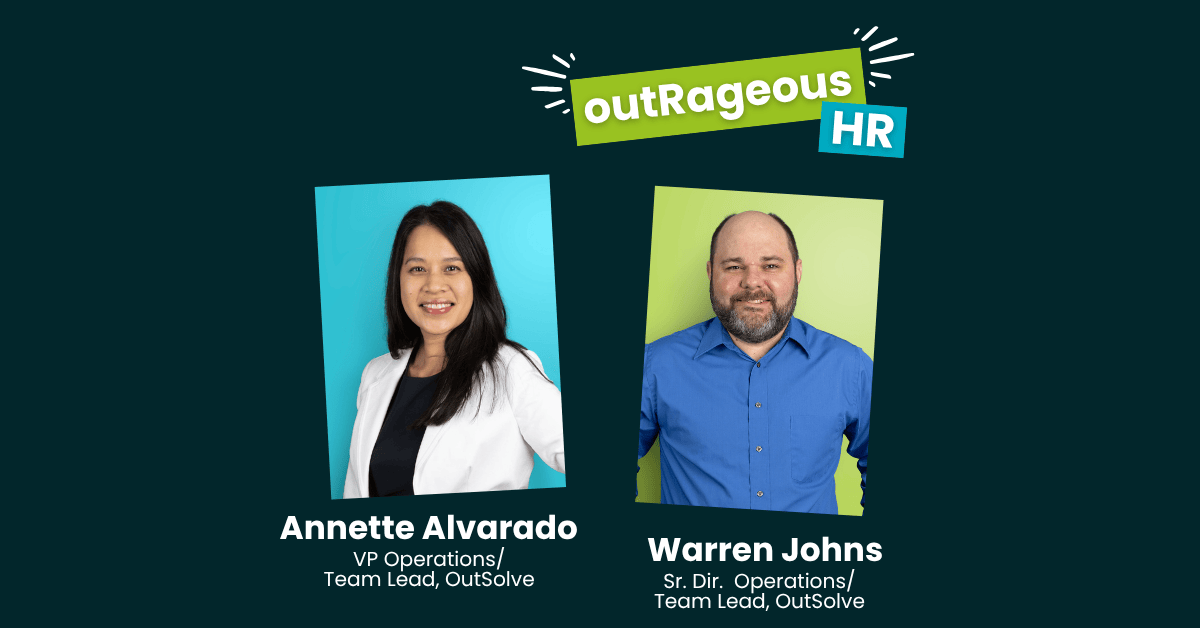7 min read
I-9 Crackdown: What New Immigration Rules Mean for Your Workforce: Part 1
![]() OutSolve
:
May 15, 2025 4:32:57 PM
OutSolve
:
May 15, 2025 4:32:57 PM

OutSolve commissioned independent research on the state of immigration enforcement and the effect it may have on HR professionals. The information in these articles is provided for general education purposes.
This article is the first in an OutSolve series for HR professionals that provides an analysis of the Trump Administration’s proposed changes to I-9 employment eligibility verification and other issues related to having foreign nationals in your workforce. While recognizing that specific policy details are still emerging, this series draws on historical precedents, administration statements, and expert analysis to offer insights and provide practical guidance to HR leaders.
What Can we Expect from I-9 Employment Verification Requirements?
Within its first 100 days the Trump administration has declared, and begun implementing, significant changes to immigration enforcement policies. Among these changes, there is a particular focus on workplace verification through more stringent Form I-9 requirements. The aim is to intensify enforcement of 1) foreign worker employment eligibility and verification; 2) expand documentation requirements; and 3) increase penalties for non-compliance.
For companies across the United States that employ non-citizen workers, this implies a substantial increase in operational overhead across several departments including Legal, Compliance and especially, Human Resources, as well as potential operational impact due to staffing shifts where employes are no longer have employment authorization.
The most immediate implications for HR professionals start with an overall increase in compliance burden. This will likely lead to increased frustration among hiring managers and overall workforce disruption. And if the lack of direction from federal agencies regarding implementation of new import tariffs is any indication, there will likely be significant uncertainty about how to implement new, more stringent foreign worker hiring practices. Of course, organizations with higher percentages of immigrant workers face the greatest exposure to these policy shifts.
Key Administration Announcements to Date
The current administration has reaffirmed its commitment to implementing stricter immigration controls as a policy cornerstone. Among these early-days announcements is the intention to enhance workplace enforcement through more stringent I-9 verification requirements. In particular, the executive order signed on January 20, 2025 entitled “Protecting the American People Against Invasion”, specifically addresses the I-9 process. The order intensifies worksite enforcement and stricter compliance with immigration laws. These announcements align with the administration’s broader "America First" employment policies that prioritize opportunities for U.S. citizens and permanent residents. The executive order specifies:
- Expanded employer verification requirements
- More frequent and comprehensive I-9 audits
- Higher penalties for documentation violations
- Enhanced collaboration between U.S. Immigration and Customs Enforcement (ICE) and the Department of Labor (DOL)
- Potential implementation of new electronic verification systems beyond the current E-Verify program
Historical Context of Employment-Based Immigration Policies
Employment eligibility verification has evolved since the Immigration Reform and Control Act (IRCA) of 1986 first established Form I-9 requirements. Subsequent developments included:
- The Illegal Immigration Reform and Immigrant Responsibility Act of 1996, which established the E-Verify pilot program
- Enhanced enforcement initiatives during the Bush administration (2001-2009)
- The Obama administration's strategic enforcement approach focused on employer compliance
- The first Trump administration's (2017-2021) increased worksite enforcement actions and I-9 audits
- The Biden administration's (2021-2025) more targeted approach to workplace immigration enforcement
These historical shifts demonstrate how employment verification has consistently been used as a key mechanism for immigration control, with varying degrees of enforcement intensity across different administrations.
Stricter Enforcement vs. Actual Policy Changes
It should be noted that most of the statements from the Trump Administration concerning foreign workers are about more strict enforcement of existing regulation than actual changes in policy. For example, there is a clearly stated intent to conduct more I-9 audits, impose higher penalties for documentation errors, and require use of E-Verify. Audits, penalties and the E-Verify process are already in force. The expectation is that the current administration will enforce them with more intensity.
However, some adjustments related to H-1B visa issuance do rise to the level of actual policy change. For example, the administration intends to narrow the definition of “specialty occupation” for H-1B purposes which amends the nature of who qualifies. The effects of this redefinition effort are expected to hit the tech industry first; particularly software engineering jobs. (National Law Review). It has also raised the fee for H-1B lottery registration from $10 to $215 per applicant. While seemingly tactical, this price increase amounts to a policy change in that it is designed to eliminate frivolous applications and enhance the “quality” of employers participating in the lottery.
Key Considerations for Employers
- Document Verification: More stringent enforcement of document authentication requirements. NECA.
Under current federal regulations, employers must physically examine the original, unexpired documents presented by a new hire to complete Form I-9. This examination must occur within three business days of the employee's start date. Photocopies are not acceptable, except for certified birth certificates. USCIS This in-person review must occur within three business days of the employee’s first day of paid work. Federal Register
Recently, the Society for Human Recourses Management (SHRM) reported that the Trump Administration has tightened document authentication requirements directing USICE to focus on both technical paperwork violations and more serious instances of document fraud. Separately, USCIS will no longer accept visa stamps alone for work authorization purposes. For Form I-9 employment verification purposes, a foreign passport must also be accompanied by a Form I-94/94A Arrival-Departure Record. USCIS
Overall, employers are facing increased scrutiny regarding acceptable identification documents. - Expanded E-Verify Mandate: Potential nationwide mandatory implementation of E-Verify for all employers, not just federal contractors and certain state-mandated businesses. Dept of Homeland Sec
- Increased Frequency of I-9 Audits: Projections indicating a rise to 12,000–15,000 ICE audits annually, a substantial increase from previous years. Thomson Reuters
- Higher Penalties for Non-Compliance: Stated DHS fines for I-9 violations include $2,861 for paperwork errors and $28,619 per violation for hiring unauthorized workers. ReedSmith
- Enhanced Enforcement Actions: Employers should be aware of according to ICE
- ICE’s Notice of Inspection (NOI) and subsequent NOI Results process
- Unannounced site visits and audits
- Requests for comprehensive documentation, including payroll records and employee lists
- Potential issuance of Notices of Intent to Fine (NIF) for substantive violations
- Mandatory Use of Updated I-9 Forms: Employers must utilize the latest version, dated 01/20/2025, which includes updated terminology and a revised DHS Privacy Notice. USCIS
- Extended Lookback Periods: Beyond current standard of three-years
- Reduced Correction Periods: Shorter timeframes for employers to address deficiencies identified during audits (as yet undefined)
- Introduction of G-Verify Proposal: New proposed requirement for employers to submit I-9 forms electronically, facilitating real-time verification and enforcement. Financial Times
The following chart provides a simplified historical perspective for many of the recently announced changes to I-9 and H-1B visa policy and administration. The comparison timeframe covers the previous two administrations dating back to 2017.
| Policy Element | Historical Application 2017 - 2024 |
Expected Changes 2025 → |
|
Enforcement Focus |
Targeted industry sweeps |
Systematic audit expansion across all sectors |
|
I-9 Verification |
Simpler form |
Updated with stricter terms |
|
I-9 Enforcement |
Limited audits and fines |
Increase annual audits to 10,000+; Increase fines up to $28,000 per violation |
|
E-Verify |
Voluntary adoption |
Potential mandatory nationwide implementation |
|
Penalties |
Variably enforced |
Significantly higher with consistent enforcement |
|
Technology |
Basic electronic forms |
Advanced biometric and AI-driven verification |
|
Interagency Coordination |
Limited |
Comprehensive coordination between ICE, DOL, and other agencies |
|
Lookback/Correction Periods |
Three years / Loosely defined |
Extend beyond three years / Shorted and clearly defined |
|
H1-B Visa allocation |
Lottery selection |
Merit-based selection; narrower definition of “specialty occupation” |
|
H1-B Visa wage minimum |
Not tightly regulated |
Minimum salary requirements to match prevailing U.S. wage |
These policy shifts and more strict enforcement intentions will have significant implications for U.S. employers, particularly in sectors reliant on immigrant labor such as technology, agriculture, and academia. Increased visa processing times, stricter eligibility criteria, and the reduction of available foreign workers may lead to labor shortages and impact economic productivity.
Expected Timeline for Potential Implementation
While specific implementation dates have not been officially announced, the following timeline represents a likely sequence based on administrative signals:
- Q2-Q3 2025: Initial directives and executive orders outlining enhanced enforcement priorities
- Q3 2025: Publication of proposed regulatory changes to I-9 processes
- Q4 2025: Beginning of increased ICE audit activity targeting high-priority industries
- Q1 2026: Implementation of initial changes to verification requirements
- Mid-2026: Full implementation of enhanced verification systems and expanded E-Verify requirements
This timeline assumes standard regulatory change processes will be followed.
Recommended Actions for HR Professionals to Ensure I-9 Compliance
- Conduct a Full Internal I-9 Audit
- Review all existing I-9 forms for completeness, accuracy, and timeliness
- Address any deficiencies before potential ICE audits
- Ensure all systems or vendors used for employment verification have updated their processes
- Ensure Use of a Valid Version of the I-9 Form
- The most recent form has updated terminology and DHS Privacy Notice
- The form issued on 08/01/23 is also acceptable
- Train all hiring managers and HR staff on the changes
- Implement a Documented I-9 Compliance Policy
- Standardize procedures for document verification and I-9 storage
- Include guidance on timelines and handling errors
- Train HR and Compliance Teams
- Conduct training on proper I-9 completion, document review, and anti-discrimination practices
- Prepare for audits, including mock audit simulations
- Prepare for Unannounced ICE Visits
- Designate an internal response team
- Preassemble necessary documentation (payroll records, employee lists, past audit responses)
- Stay Informed About G-Verify
- Monitor developments on the proposed G-Verify system requiring electronic submission
- Prepare for digital infrastructure upgrades
- Shorten Internal Correction Timelines
- Implement faster internal review and correction cycles in line with reduced DHS correction periods
Recommended Actions for H-1B Visa Program Readiness
- Through Review of H-1B Workers’ Status and Responsibilities
- Analyze roles, qualifications, and prevailing wage compliance
- Anticipate changes to the “specialty occupation” definition and merit-based selection
- Benchmark Salaries Against Prevailing Wage Data
- Ensure H-1B wages meet or exceed new minimum thresholds being signaled by the administration
- Coordinate Closely with Legal Counsel
- Work with immigration attorneys to anticipate application risks under new rules
- Develop contingency plans for delayed or denied visas
- Update Immigration-Related Job Descriptions
- Clearly align job duties with H-1B criteria to support future applications under narrower guidelines
- Diversify Talent Pipelines
- Reduce over-reliance on foreign national workers by investing in domestic hiring pipelines
- Reduce over-reliance on foreign national workers by investing in domestic hiring pipelines
Ongoing Strategic and Compliance Recommendations (for executive leadership)
- Establish Cross-Functional Task Force
- Include Legal, Compliance, IT, and Talent Acquisition to prepare for enhanced enforcement
- Engage in Workforce Impact Analysis
- Model the potential operational and financial impact of losing access to immigrant labor
- Monitor Executive Orders and Federal Register
- Track updates on implementation timelines, E-Verify expansion, and biometric requirements
- Educate Internal Stakeholders
- Keep leadership informed about immigration risks, audit exposure, and workforce planning
- Budget for Increased Compliance Costs
- Allocate resources for technology upgrades, legal consultation, and potential penalties
Summary
In this post we examined the Trump Administration's active and proposed changes to U.S. policies on immigrant employment requirements related to I-9 form verification and H-1B visa criteria. It’s clear that, when fully enacted, these changes will have a significant impact on workforce management for organizations that employ immigrant workers.
The expected changes include intensified enforcement of foreign worker eligibility verification, expanded documentation requirements, and increased penalties for non-compliance. The administration's January 2025 executive order "Protecting the American People Against Invasion" specifically targets the I-9 process with provisions for expanded employer verification requirements, more frequent audits, higher penalties, enhanced cross-agency collaboration, and potential new electronic verification systems. The portion of this directive related to immigration process is summarized by a notice published by the U.S. Customs and Immigration Services.
While many changes represent stricter enforcement of existing regulations rather than new policies, some adjustments to H-1B visa issuance constitute actual policy shifts, particularly affecting the tech industry. HR professionals should prepare for increased compliance burdens, potential workforce disruption, and implementation challenges as these policies unfold.
Next up: a look at the industries and regions of the U.S. expected to be most impacted by these policy and enforcement change.
Related Articles and Webinar
- I-9 Crackdown: What New Immigration Rules Mean for Your Workforce: Part 1
- The New Reality of Immigrant Workforce Management and Compliance - Part 2
- New Administration, New Compliance Challenges for Human Resources: Part 3
Interested in more I-9 related content? Sign up for our June 4 webinar titled Strengthening I-9 Compliance Amid Immigration Enforcement. Click below to register.
Founded in 1998, OutSolve has evolved into a premier compliance-driven HR advisory firm, leveraging deep expertise to simplify complex regulatory landscapes for businesses of all sizes. With a comprehensive suite of solutions encompassing HR compliance, workforce analytics, and risk mitigation consulting, OutSolve empowers organizations to navigate the intricate world of employment regulations with confidence.
Weekly OutLook
Featured Posts

The Federal Government Shutdown Lingers: HR Professionals Take Action

HR Planning: 5 Planning Steps for Q4
Related Posts

Breaking Down the Notice of Inspection for ICE Audits
Getting a Notice of Inspection (NOI) from U.S. Immigration and Customs Enforcement (ICE) can make any HR professional nervous. While it may seem...

CHRO Survival Guide: How CHROs Can Navigate the Regulatory Rollercoaster
Welcome to the first of our 3-part research series titled CHRO Survival Guide: Navigating Today's Regulatory Change and Challenges. This part dives...

HR Compliance Consulting: Maximize Efficiency in the New Year
It’s that time of year for new goals, new budgets, and new opportunities to strengthen your organization. The beginning of the year is an ideal time...

